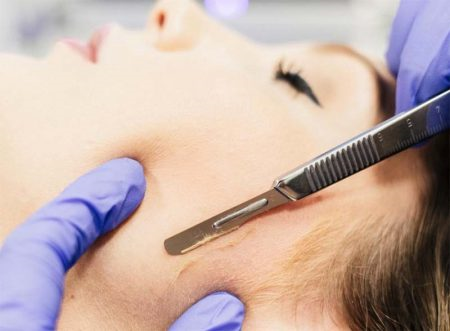
What does dermaplaning do to your skin?
Dermaplaning leaves you with slightly brighter, smoother skin by scraping off the top layer of dead skin cells, peach fuzz, and excess oils with a scalpel. The deep exfoliation treatment can remove up to two weeks of dead skin, and the results last about three to four weeks.
Aside from helping you get very soft skin, dermaplaning also smooths out uneven skin texture and gives you a smoother base for your foundation and makeup (since it doubles as a facial hair removal treatment), which means no more cakey makeup for you. “Dermaplaning is like a turbo-charged exfoliator,”
BENEFITS OF DERMAPLANING
Improves fine lines and wrinkles, promotes collagen formation, lightens brown spots, reduces acne scarring, and promotes healthy cell turnover. All while leaving the skin with a smoother and healthier appearance. Once the dead outer layer of skin and peach fuzz are removed, products penetrate the skin easier, and make-up goes on easier so your skin looks smoother.
WHAT ABOUT REMOVING HAIR ON THE FACE?
It is a common wives tale that when a female “shaves” the hair from her face it will grow back as thick dark hair, like a male’s. The truth is that it is male hormones that promote their facial hair to grow thick and dark, not the actual event of shaving. A female’s hair will grow back exactly as it was prior to the dermaplaning. Peach fuzz traps oil and debris on the surface of the skin making it appear more dull. Hairless skin is much softer and smoother.
DERMAPLANING AS A STACKING TREATMENT
Dermaplaning is most beneficial when stacked with other procedures, such as a prior to a light chemical peel. The chemical peel can penetrate much deeper when dermaplaning is done prior. It is also beneficial to be done prior to certain types of microneedling or even prior to applying a serum treatment protocol. This protocol will give the skin a much more desired cosmetic outcome- like a skin treatment on steroids!
CAN ANYONE DO DERMAPLANING?
All skin types and colors can enjoy this procedure. The only time it is contraindicated is with active pustular acne. It is important to know that dermaplaning is a maintenance treatment, like a facial. So keep in mind, that if our skin makes an entirely new layer every 6 weeks, this procedure is going to provide the best outcome if done every 4-6 weeks.
When should you avoid dermaplaning?
You’ll want to avoid dermaplaning if you’re experiencing an active acne, rosacea, psoriasis, or eczema flare-up, since the treatment could cause further irritation and excessive skin
Enjoy!

